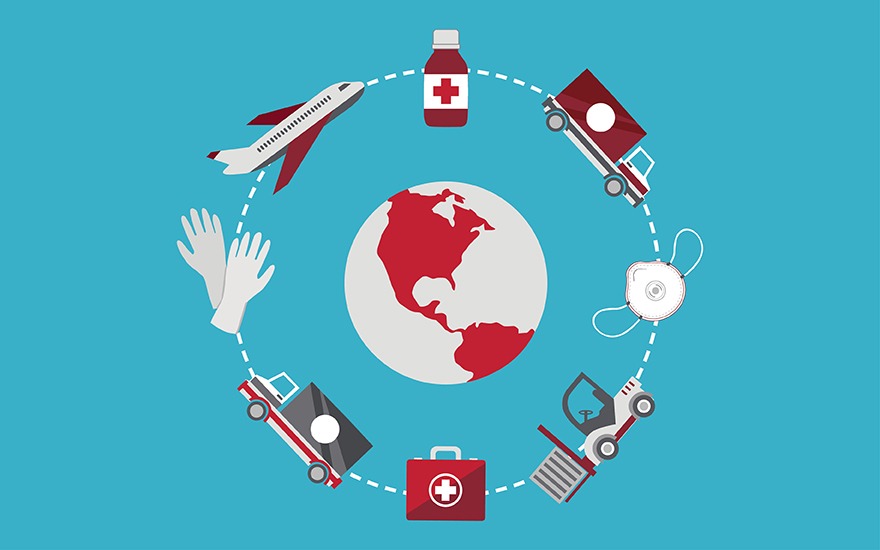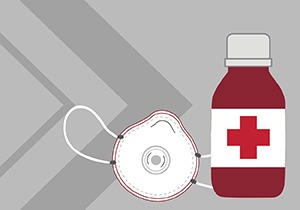
Normally a behind-the-scenes operation, the COVID-19 pandemic has pushed supply chain and supply chain issues to the forefront of global discussions. As Americans respond to shortages by making their own masks and hand sanitizers, the demand for “personal protective equipment” (PPE) at both the individual and the health care industry level is immense.
But what exactly does the term “supply chain” mean and how does it function during a public health emergency like COVID-19, particularly when the demand vastly outpaces the supply?
Greg DeCroix, academic director of the Grainger Center for Supply Chain Management at the Wisconsin School of Business and a professor of operations and information management, and Pete Lukszys, a WSB senior lecturer, are lending their expertise through several collaborations during this unprecedented COVID-19 pandemic.
Understanding supply chain
As a definition, “an organization’s supply chain consists of all the processes, facilities, vehicles, people, and companies that are involved in acquiring and transforming materials and delivering them to ultimate customers,” DeCroix says. “A supply chain is all about matching supply with demand. With COVID-19, supply and demand have had huge shocks to them—that’s true for many industries, but it’s particularly critical for PPE. On the demand side, it’s really important to know, how much are we using and what activities are driving that? On the supply side, you want to look at identifying what you have, controlling what you have, being careful about how it’s distributed—stretching the supply as long as possible—and then working to acquire more.”

With the current PPE shortages, organizations need to assess which particular activities consume PPE, and whether operations might be reorganized to reduce usage. For example, medical facilities are redesigning patient flow to keep suspected COVID-19 cases separate from non-COVID patients, and minimizing the number of employees coming in contact with the COVID patients, thus reducing the number of people needing to use PPE items.
Keeping a line of communication open with suppliers is also vital, as the processes for filling orders may be different than when supply is plentiful. “When distributors are swamped with orders, customers will get put on allocation,” DeCroix says, “which means that customers might receive some supply but not the full amount they initially requested.” Depending on the company, the order may be filled on a historical basis—for example, a percentage of how much the customer has traditionally ordered in the past—or orders might be prioritized based on end use, such as giving priority to direct COVID-19 patient care. Understanding how a submitted order will be managed—where one is in the “queue”—is key to seeing that order fulfilled.
In extreme cases like the current one, it also may be necessary to identify alternative sources or other ways to stretch supply. Depending on the situation and within medical guidelines established by the CDC or others, DeCroix says, it may be necessary to use PPE that has passed its expiration date, or find ways to sterilize and reuse PPE and equipment.
Organizations have also started going outside of traditional supply sources, partnering with universities and private companies to design alternative versions of some items and develop local production capabilities. This kind of big picture, supply chain strategizing is crucial right now. It’s about an alternative way of thinking, one that brings new resources together to solve problems and finds the most achievable solutions. Supply chain professionals across the country are working through all of the key elements involved with this urgent PPE production, which is complex and includes expertise in design, materials, product testing, scaling operations, forecasting, and cost recovery.
Building PPE capacity
DeCroix observes that a substantial percentage of the world’s PPE supply, including around 50% of N95 face masks—the perennially out-of-stock medical grade masks that U.S. health care providers are desperate to get hold of—is produced in China.
When the COVID-19 virus hit in late 2019, “naturally China had the need first,” he says. “So, a big portion of the supply chain was inaccessible given its location and given that the virus hit there first. Any ‘cushion’ in the supply chain evaporated because of those places that had the first immediate needs.”
Masks and other PPE are coming out of U.S. producers; however, the supply of PPE isn’t being produced fast enough to match the incredible demand needed to support the anticipated number of COVID-19 cases.
—WSB Senior Lecturer Pete Lukszys
As most U.S. residents know by now, ventilators are in short supply, but so are the N95s. That’s partly due to the quality of the mask’s construction: it is better at filtering out small particles thanks to special synthetic fibers, and offers a tighter fit for the face. “With effort and creativity, people can figure out how to make gowns, how to make face shields, and how to make procedure masks, but the N95 is the nut that’s the hardest to crack,” DeCroix says.

Based on what Lukszys and DeCroix are hearing from distributors, Lukszys says, “the consensus is that we can expect a two-fold increase in gown usage, a five-fold increase in face mask usage, and a 10-fold increase in N95 usage.”
Given those figures, companies are scrambling to keep up with the projected demand.
“U.S. companies are ramping up PPE production as rapidly as they can,” DeCroix says. “You have this really, worst-case scenario from a supply chain perspective where demand is skyrocketing and simultaneously supply is being slashed. In an ideal scenario, you have supply and demand in a nice sort of flow.”
For some companies, the only way to increase production is to keep the equipment running as much of the day as possible, manufacturing PPE over multiple shifts.
Despite the delays, “the supply chain is up and running,” Lukszys says. “Masks and other PPE are coming out of U.S. producers; however, the supply of PPE isn’t being produced fast enough to match the incredible demand needed to support the anticipated number of COVID-19 cases. One thing that is helpful is the supply in the U.S. is originating from multiple companies, producing at multiple locations. If all the manufacturers were based in, let’s say, New York City, or California, or Washington state, we’d be in a lot worse situation because they would have a labor shortage. Multiple locations reduces the risk of labor shortages and means you can get more product out.”
Innovation through collaboration
DeCroix and Lukszys are both experts in their fields, having studied the impact of supply chain issues across numerous industries. In this unprecedented situation, their expertise is being tapped into to address some of the most critical PPE and supply chain-related issues. Even though many of the collaborations were initiated at the campus level, their efforts will have a far-reaching impact, embodying the Wisconsin Idea that learning and knowledge shared extends out to state, national, and even global communities, well beyond just the university itself. Here are several of the COVID-19 projects DeCroix and Lukszys are involved with:

Creating procedure masks. Lukszys is part of a core campus team, including the University of Wisconsin–Madison’s School of Human Ecology and the UW College of Engineering, that is working to design, prototype, and locally contract manufacture a procedure mask. “The UW campus and area hospitals anticipate a potential shortage of these masks, and with traditional channels of distribution being backordered, we decided local production was necessary,” he says.
“It’s almost like launching a mini startup operation to get these masks to researchers and clinicians at UW,” Lukszys says. After identifying and testing the fabrics—“we had to be very creative in finding filtration materials that could be sourced during the pandemic, looking at things like landscaping material, surgical wraps, and even vacuum cleaner bags”—the team created a prototype and connected with a Wisconsin manufacturer for eventual use at UW–Madison and UW Health.
Working with UW–Madison’s Emergency Operations Center. DeCroix and Lukszys were asked to lend their expertise in evaluating the university’s PPE supply and demand, tasked with understanding how much PPE campus has, where it is stored, and at what rate it is being used. “There’s no central place you could just go and get those numbers,” explains DeCroix. The next step was talking with suppliers and distributors, keeping the lines of communication clear. “We wanted to make sure that they see UW as a long-term partner, so that if we put orders forward that clearly identify who it’s coming from and what the needs are, that they will be treated appropriately and won’t accidentally fall through the cracks.”

Forecasting models for hospitals. UW Health reached out to DeCroix and Lukszys on forecasting demand for hospital masks and gowns. “I teach courses on supply chain analytics and operations analytics, so I have a strong interest in predictive analytics and forecasting,” DeCroix says. He and Lukszys identified a number of models that could help UW Health forecast patient volume, and are working to help them translate those forecasts into PPE usage estimates.
Providing supply chain best practices. Through a connection via one of his Wisconsin Evening MBA students, DeCroix collaborated with Medical College of Wisconsin faculty on an upcoming article that provides recommendations around supply chain and operations in the context of PPE.
Creating connections to support solutions. Both Lukszys and DeCroix have been working to connect different groups and individuals who want to contribute to solutions to the supply shortages. “There are so many people wanting to help,” DeCroix notes. “Through his work with procedure masks, Pete is connecting with designers, engineers, manufacturers and health care providers, and communicating with a community of entrepreneurs. I’ve connected with other groups of health care providers, with members of other emergency response efforts, and with a group consisting of many Wisconsin companies in the transportation industry.” Both Lukszys and DeCroix are trying to connect as many of these people as possible to help create opportunities for identifying solutions.
A multifaceted public health crisis demands a multifaceted response. Even though the PPE needs created by COVID-19 are overwhelming, companies are stepping in to fill the gaps using innovative thinking, forward-thinking approaches, and collaborative action. In the midst of significant disruption and uncertainty, there are bright spots on the horizon.
“The good news is there is so much intelligence, knowledge, creativity, and access to technical things whether it’s equipment, computing power, whatever, that we can draw on to respond,” says DeCroix. “It’s not immediate, but there’s just so much effort out there. People are trying to figure out partial solutions to this whole picture.”
Tags: